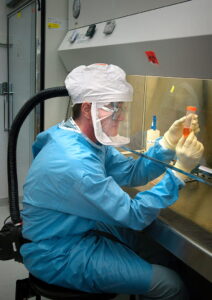A forensic pathologist is called upon by a coroner to investigate the cause of sudden and unexplained deaths. Forensic pathologists perform post-mortems–better known as autopsies. Post-mortems are usually able to determine cause and time of death by examining the tissues of the body. These tissues can include the skin as well as other organs, such as the brain. However, there is more to analyze than just tissue; a forensic pathologist also analyzes the clothing, urine, bile, hair, blood, nail clippings and stomach contents of the victim.
To start their investigation, a forensic pathologist will go out into the field to examine the scene. After this, the rest of the forensic pathologist’s work takes place in a laboratory that is well-lit and clean. While examining the victim, a forensic pathologist wants to collect as much information as possible on the events surrounding the death of the victim and on what their health was like at the time. Knowing a victim’s medical state is important in assessing the possibility that the death occurred due to natural causes. If the possibility of death by natural causes is dismissed, the pathologist must determine if the death was a suicide, a homicide, or an accidental death. In determining the cause of death, a forensic pathologist does not work alone. Generally, a forensic pathologist seeks help from other specialists, such as a toxicologist. A toxicologist can help determine the cause of death by searching for poison and detecting alcohol levels.
In addition to examining the death, forensic pathologists also testify in court to present the evidence that has been found relating to the cause of death and time of death. It is important for a forensic pathologist to be prepared for these aspects of the job as well as the examination aspect.
To become a forensic pathologist, one must have a lot of schooling just like any other medical career. Typically a forensic pathologist needs four years of medical school and then an additional three to four years of either anatomical or clinical pathology. A growing trend now has aspiring forensic pathologists completing a one year fellowship at an approved medico-legal investigation facility as part of their training. At this facility, they must perform 200- 300 autopsies to maintain their accreditation. Usually, the training is done at a medical examiner or coroner’s office. An aspiring forensic pathologist must also pass a written and practical exam set by the American Board of Pathology. Once board certified, every ten years there is a recertification so that they can stay up to date with the latest procedures.

